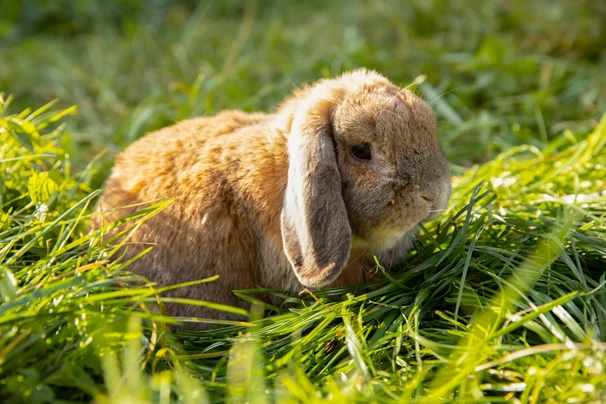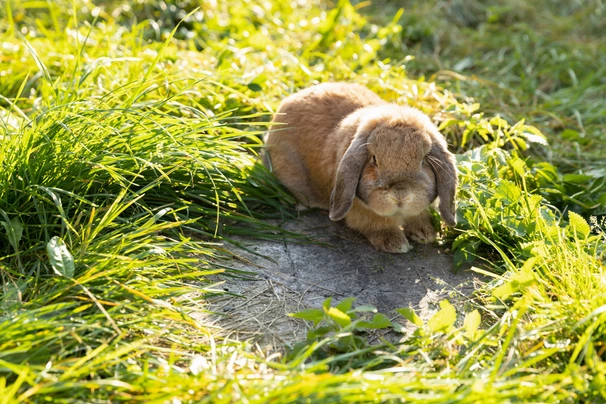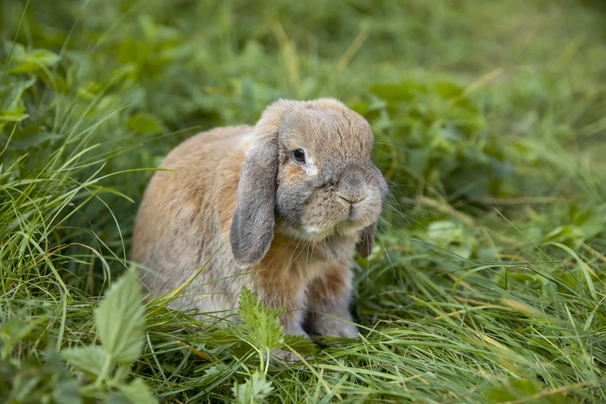German Lop
Introduction of the German Lop
The German Lop was developed by fanciers in Germany in the 1960s when it was decided that a medium-sized lop animal was needed to complement the English, French and Dwarf varieties. The result of their efforts is a well-rounded, ‘cobby’ rabbit that certainly has a cute and cuddly appearance and a striking Roman nose.
The German Lop is well-known for its calm, pleasant demeanour and is not too large, and therefore makes an ideal pet or show animal. The does make excellent mothers and can raise large litters of robust and vigorous kits. However, they do have a tendency to moult thanks to a very thick undercoat, so potential owners should be prepared for lots of grooming and vaccuming if your rabbit is to be kept indoors.
History of the German Lop
Following the development of the other well known lop breeds – the French, the English and the Dwarf – fanciers in Germany in the 1960s wanted to develop a medium-sized lop type. Although it’s widely known that both the French and the Dwarf Lops were used in the foundation of the breed, there is another breed in the mix that lends the German Lop its distinctive ‘hooked’ nose so it’s certainly not just another lop in a different weight bracket.
The German Lop was recognised officially in Germany in 1970 and given the title Deutsch Klein Widder. It had made its way into Holland by 1972 and was recognised in the Netherlands in 1976. Although the German Lop has not travelled very far from Holland and Germany, the breed is very well-regarded and it may never have made its way into the UK if a Dutch breeder had not moved to Britain in the 1980s, bringing the German Lop with her. After fanciers worked hard to develop a standard for the German Lop in the UK, it was eventually recognised by the BRC in 1990. Although early British examples were primarily agouti, as other fanciers became interested in the German Lop, so they began to take an interest in other colours that were already available on the Continent and some of these were imported into Britain to add variety to the breed.
Considering that this breed is a relatively new one to the UK, enthusiasts were delighted when a white example, bred in Britain, took Best in Show at the 1998 London Championship Show. The breed has been popular in the UK ever since and is a consistent winner
Appearance of the German Lop
- Main colourways: All colours, as well as the butterfly pattern, are accepted by the breed standard
- Average weight: 2.9 – 3.9kg
The breed standard states that the ideal type for the German Lop is ‘very cobby, massive and muscular’. While this may make the German sound like the Arnold Schwarzenegger of rabbits, what this body types means in that he’s round, compact and looks very cuddly indeed.
The neck should be barely visible and the head is round, with a distinct ‘hooked’ profile and pronounced cheeks. The front legs are robust, short and straight and the back legs should sit parallel to the rump and the feet should not stick out when the animal is at rest.
Rising from a crown on the top of the head, the ears are thick and wide and should hang over the cheeks and behind the eyes. The insides of the ears should not be visible. The coat, which should be of a moderate length, is thick, dense and very soft and has a very healthy undercoat with thick guard hairs. Because of this dense undercoat the German Lop can blow its coat in quite a spectacular fashion so care should be taken around springtime, when the rabbit will begin to moult.
Temperament of the German Lop
The German Lop has a calm, docile and very likeable personality, which means it makes a great pet, show animal or both. Although any owner should know about rabbit husbandry and care before they take on a new pet, the German Lop is perhaps a good rabbit to start with as it’s so calm and of a manageable size.
If you provide him with some toys to play with – cat toys with bells and rattles are popular – he will play with them and may even allow you to join in once he’s got used to you. All rabbits are nervous as they are prey animals, so any new pet should be allowed to get used to human company when they’re young.
It’s very important to learn how to carry and hold a rabbit as they can panic and struggle if they feel unsafe or uncomfortable. Because they carry a lot of weight at their hind end, if the rear is not supported and they feel vulnerable, they may panic and struggle, which can cause spinal injuries. If he does struggle he may also cause injuries to his owner too as he will be a lot stronger than he looks.
Health of the German Lop
Many breeders keep their lops in hutches in sheds as this way, the animals are exposed to the elements somewhat, but protected from the worst of the weather. It’s a good idea to make sure that wherever you decide to keep your rabbit is where they live permanently. That’s not to say that if you have a hutch-kept rabbit he shouldn’t spend an hour or two indoors for play or to explore, or that a house rabbit shouldn’t have access to the outdoors. Rabbits that are kept partly indoors and partly outdoors never get used to one climate and therefore can be susceptible to chills and respiratory problems.
Teeth should be checked regularly and roughage should be fed to keep the teeth, which grow continually, worn down. Overgrown teeth can cause injuries in the mouth and can make eating difficult. If you suspect a problem, veterinary advice should be sought without delay.
Because of their friendly and affectionate nature, they do have the ability to elicit regular treats from their owners and can have a tendency to become overweight. Their diet should be monitored closely to avoid obesity, as overweight rabbits are prone to flystrike.
All rabbits should be wormed and treated for fleas and ticks regularly. They should also be vaccinated annually against myxomatosis and Viral Haemorrhagic Disease. Does not intended for breeding should also be spayed to prevent uterine cancer.
Caring for the German Lop
Before your German Lop comes home you should decide where he’s going to live. They can do very well being kept in a hutch outdoors, although any hutch should be weather and waterproof and kept out of direct wind and sun. If you can place the hutch in a well-lit, ventilated shed this would be ideal. Rabbits also benefit from company so it may be worth considering getting two rabbits – two neutered males or a neutered male and a female would be best. Never house a rabbit with a guinea pig as the larger animal could injure the smaller rodent.
If he’s going to live in the house he should be taught to use a litter tray and provided with a secure area such as an indoor cage or dog crate where he can go to relax. Cables and wires must be kept out of the way and any living quarters – indoor or out – should be cleaned out thoroughly each week. Droppings should be removed every day.
His diet should comprise good rabbit pellets and good quality hay, as well as lots of fibrous green leaves and vegetables such as dandelions, kale and spring greens. He should also have permanent access to fresh, clean drinking water.


